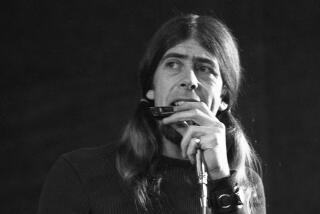THE RECORD RACK : CLAPTON: IN THE ‘80S, THE NAME IS ERIC, NOT ICARUS : “BEHIND THE SUN.” Eric Clapton. Duck/Warner Bros.
- Share via
Eric Clapton, truly the cream of Britain’s ‘60s guitar heroes, won’t be caught dead making any waves. For a decade, Clapton has exhibited nothing but grand-old-bluesman class and dignity, none of the paisleyed flash of his salad days. Now comes another Clapton album, rife with more cautiously updated bluesiness--serious, rootsy, real .
The problem is that Clapton the whiskey-voiced blues realist has never seemed quite as authentic, in his way, as Clapton the tpashy, psychedelic guitar god. Because Clapton’s authenticity lay in his sublime white synthesis of blues and ‘60s acid reverie, in those pungent, cerebral, celestial guitar leads--Cream-era Clapton was a sunshine superman with the dark soul of a Hendrix, and that made him special.
Yet, beyond “Layla” and isolated gems like “Cocaine,” Clapton the bandleading solo star is not very interesting. His late-’70s solo albums exhibited a lot of maturity and a sincere feel for gospel and rural-soul idioms, but they were also so full of atonement and down-to-earthness that Clapton seemed to be apologizing for flying too close to the sun in the ‘60s. Clapton freaks understood, of course, and their loyalty makes sense, even if “Behind the Sun”--again, that diffident, mellow-man, sunset-years approach--is more of the same.
This time it’s Phil Collins producing, slipping in the chrome-clean synthesizer environments where once Clapton would have real, juicy horns. The music has weight, groove, Jamie Oldaker on drums, “Duck” Dunn on bass--in other words, shoals of muscle. “Same Old Blues” is a highlight, slow and witty, and a square-measured remake of “Knock on Wood” is so well-seasoned who cares if the horns are synthetic? Throughout, Clapton lays in some eloquent guitar leads, but steadfastly refuses to show off. Admirable.
Then again, there’s the nagging sense that Clapton has become a vehicle, another good point man for the empire-building Collins, for Ted Templeman and Lenny Waronker, who co-produced three tracks, and for Warner Bros., which appreciates the marketability of a name . But there remain those for whom Clapton’s bankable ‘80s name and mature craftsmanship must pale beside his trashy, unforgotten ‘60s soul.
WEARY PROJECT
“VULTURE CULTURE.” The Alan Parsons Project. Arista. If you miss Supertramp, run don’t walk to “Vulture Culture,” the latest tinkly-bouncy-catchy-conceptual Anglo-rock concoction from a “group” that has raised the lack of identity to heights undreamt of by the likes of Toto, Journey and, uh, Supertramp.
The most impressive thing here is producer-engineer-”programmer” Parsons’ canny mimicry of a brass section via the Fairlight synthesizer. Some vague snippets of dialogue and a portentous snake-swallowing-its-tail album cover allude to weighty matters, none of which are fleshed out by the material, which sighs wearily about this material world and concludes with a stunning “Taking my life, one day at a time, ‘cause I can’t think what else to do.” How about don’t make albums? Or at least find a good lead singer before taking on another “project.”
More to Read
The biggest entertainment stories
Get our big stories about Hollywood, film, television, music, arts, culture and more right in your inbox as soon as they publish.
You may occasionally receive promotional content from the Los Angeles Times.









